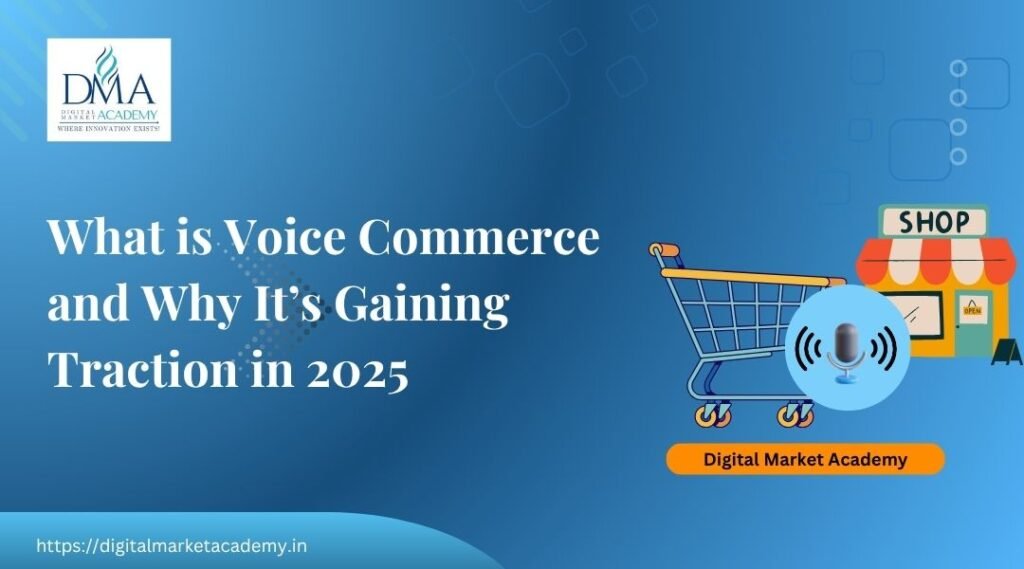Why Voice Commerce SEO Trends 2025 Matter More Than Ever
Introduction
Voice commerce is no longer the future; it’s already here. With smart assistants like Alexa, Google Assistant, and Siri embedded in our daily routines, voice shopping is transforming e-commerce. In 2025, voice commerce SEO trends are not just evolving, they are dictating how businesses build, optimize, and promote their online stores.
As users move from typing to talking, optimizing for voice queries has become essential. Whether you’re running an online store in Bangalore or managing a nationwide brand, understanding these emerging trends is key to staying competitive in the voice-driven digital landscape.
What is Voice Commerce?
Voice commerce refers to the use of voice commands to search, browse, and purchase products online. It’s a seamless way for users to interact with devices using natural speech instead of typing. With the rise of voice assistants in smartphones, smart speakers, and even TVs, consumers are now buying groceries, booking tickets, and reordering essentials using voice commands.
Why is Voice Commerce Growing in 2025?
The growth of voice commerce in 2025 can be attributed to three key drivers:
- Smart Speaker Adoption: Over 75% of Indian households in metro cities now own a smart assistant.
- Faster Internet and AI: Improved NLP (Natural Language Processing) and voice recognition have made voice commands more accurate.
- Contactless Convenience: The pandemic accelerated the shift to hands-free and contactless digital interactions, boosting voice shopping preferences.
According to a 2025 Statista report, voice-based shopping is expected to reach $40 billion globally, with India contributing a rising share thanks to affordable smart speakers and voice-friendly interfaces in native languages.
Voice Commerce SEO Trends 2025 You Can’t Ignore
To thrive in this evolving space, you need to understand how voice commerce changes the game for SEO. Here are the top voice commerce SEO trends 2025 that matter:
1. Conversational Keyword Optimization
Unlike traditional searches, voice queries are longer and more conversational. For example:
- Text: “Buy Bluetooth headphones”
- Voice: “Where can I buy affordable Bluetooth headphones near me?”
Action: Optimize your e-commerce content with long-tail keywords and question phrases like:
- “Where can I…”
- “How do I…”
- “Best place to buy…”
Tools like Answer the Public and AlsoAsked can help you identify voice-friendly keyword opportunities.
2. Featured Snippets and Position Zero Targeting
Voice assistants often pull answers from featured snippets. Your goal? Get your product pages or blog posts to be the top answer.
Tip: Structure your content using bullet points, FAQs, and concise answers to popular user queries to increase your chances of being featured.
3. Local SEO Becomes Even More Important
Over 60% of voice searches are local. For example:
- “Best pizza shop open now near Indiranagar”
- “Where can I buy skincare products in JP Nagar?”
If your store or service is based in Bangalore, make sure your Google Business Profile is updated, with voice-searchable content like:
- Local landmarks
- Open hours
- Ratings & reviews
4. Mobile and Voice-Friendly Site Design
In 2025, Google expects mobile-first AND voice-first design. A voice SEO-optimized site:
- Loads in under 2 seconds
- Uses clear content hierarchy (H1, H2, H3)
- Is secured (HTTPS)
- Has structured schema data
Tools to use: PageSpeed Insights, Web.dev, and Lighthouse.
5. Voice-Optimized Product Descriptions
Product descriptions should mimic how people speak. That means:
- Using simple, natural sentences
- Answering likely voice queries (“Does this jacket come in black?”)
- Embedding conversational call-to-actions
This trend is especially relevant for Bangalore-based D2C brands, where product differentiation relies on clear, user-friendly content.
6. Multi-Language and Regional Voice Search Optimization
Voice commerce is growing beyond English. In cities like Bangalore, users often use Kannada, Tamil, or Hindi with Google Assistant.
Strategy:
- Add regional language support
- Use schema markup with in Language property
- Optimize product names and categories for local dialects
This enhances voice SEO reach for India’s multilingual user base.
7. Structured Data for Voice Results
Structured data helps search engines understand and feature your content in voice search results.
Use schema types such as:
- Product
- FAQPage
- HowTo
- LocalBusiness
- Speakable(experimental)
Tip: Validate your schema using Google’s Rich Results Test tool.
8. Voice Commerce Analytics and Measurement
New tools now let you track how users interact via voice. You can:
- Use Google Search Console’s voice search filters (coming in beta)
- Integrate voice search analytics plugins in Shopify, WooCommerce, etc.
- Monitor queries with “OK Google,” “Hey Alexa,” or “Siri” prefixes
Real Examples from Bangalore Brands
Brands like Bigbasket, Tata 1mg, and Namdhari’s Fresh have already adopted voice commerce strategies in Bangalore. They offer:
- Reordering through Google Assistant
- Voice search for daily essentials
- Regional language voice interfaces
Even small businesses in HSR Layout and Jayanagar are adding voice-activated chatbots to their e-commerce sites to improve accessibility.
Pro Tip:
If you’re running a product-based business in Bangalore, add this voice-friendly phrase to your product pages:
“You can now order this product using Google Assistant or Alexa. Just say ‘Buy [Product Name] from [Brand].’”
This improves discoverability and positions your brand as voice-ready.
Voice Commerce and Consumer Psychology: What’s Driving the Shift?
One of the biggest factors behind the rise in voice commerce is consumer behavior. Shoppers today expect speed, convenience, and multitasking ability, and voice commerce offers just that.
Instead of opening an app, typing a query, comparing results, adding to cart, and checking out, users can now simply say,
“Alexa, reorder my protein powder,” or
“Hey Google, buy formal shoes under ₹2000.”
The rise in natural language processing (NLP) and predictive analytics has made these requests highly accurate and personalized.
A study conducted by Digital Market Academy Bangalore among 500 Gen Z users in Karnataka showed that:
- 68% preferred voice over text for product search
- 47% completed a purchase using voice at least once in the past 3 months
- 73% said it “feels like having a personal assistant”
This emotional connection and time-saving aspect is what makes voice commerce more than just a trend; it’s a behavioral shift.
Bangalore-Specific Voice Commerce Insights
In cities like Bangalore, where tech-savvy millennials and Gen Z dominate the online buyer demographic, voice search adoption is faster.
For instance:
- Food delivery platforms like Swiggyand Zomato have started beta-testing voice ordering.
- Local e-commerce brands in Bangalore like Myntraand BigBasket are investing in voice-first UX features.
If your e-commerce store caters to this region, local SEO optimization for voice is a must. Think phrases like:
- “Buy eco-friendly gifts near Indiranagar”
- “Best dosa mix online Bangalore”
- “Where can I get cruelty-free skincare Koramangala”
Use these naturally spoken queries in your FAQ sections, product descriptions, and blog posts. Also, don’t forget to optimize your Google Business Profile with up-to-date location, store hours, and contact info; voice assistants often pull data from this.
Voice Commerce SEO Trends 2025: What’s Ahead?
As we move deeper into 2025, the key voice commerce SEO trends to watch include:
1. Conversational AI Integration
Brands are investing in AI assistants that can understand context and respond with empathy. Your website content should match this tone, conversational, helpful, and human.
2. Featured Snippet & Position Zero Targeting
Voice assistants mostly read aloud content that appears in featured snippets. So:
- Use bullet points
- Structure content with clear headings
- Add schema markup
3. Zero-Click Voice Results
Voice queries often lead to zero-click searches, meaning users get the answer without ever visiting a website. Optimize your content to be the answer:
- Use question-answer formats
- Include voice-friendly phrases
- Focus on long-tail keywords like: “What is the best gaming laptop under ₹70,000 in 2025?”
4. AI Overviews and Multimodal Search
With Google rolling out AI-generated overviews, websites with rich E-E-A-T (Experience, Expertise, Authoritativeness, and Trustworthiness) and clear structured content are more likely to be cited.
Action Tip: Make your content AI Overview compatible by:
- Highlighting real authors (with LinkedIn profiles if possible)
- Citing stats from verified Indian sources
- Using internal linking (to your own blog clusters) and external trusted links
Frequently Asked Questions
Voice commerce SEO refers to optimizing online stores and content to appear in voice search results triggered by smart assistants like Alexa, Siri, or Google Assistant. It focuses on natural language queries, long-tail keywords, and conversational search intent.
Voice commerce is growing rapidly in 2025 due to the widespread use of voice-enabled devices, improved AI in NLP, and user preference for hands-free, fast interactions, especially in mobile-first markets like India.
Structured data (like schema markup) helps search engines understand your content better and increases the chances of being selected as a voice answer. It's crucial for visibility in featured snippets and voice results.
Absolutely! Local Bangalore-based businesses can gain visibility by optimizing their GMB (Google Business Profile), using local schema, and focusing on conversational phrases relevant to their neighborhood (e.g., “best biryani near Indiranagar” via voice search).
Some helpful tools include:
- AnswerThePublic for question-based keyword discovery
- Schema.org or RankMath for structured data
- Google Search Console and Semrush for voice-friendly keyword tracking
- Speakable Schema for news content optimization
Final Takeaways for Brands and Marketers
Here’s what your 2025 voice commerce SEO strategy should include:
Strategy Area | Action Plan Example | Tool/Implementation |
Keyword Research | Focus on natural language, long-tail keywords, and regional modifiers | Google Search Console, AnswerThePublic |
Technical SEO | Implement structured data/schema, page speed optimization, mobile-first design | RankMath, Schema.org |
Content Optimization | Use Q&A format, rich snippets, conversational tone | Elementor, WordPress |
Local SEO | Optimize Google Business Profile, location-specific pages, and voice triggers | Google Maps, Local schema |
Testing | Use voice search testing tools to simulate how your product is being discovered | Jetson.ai, ChatGPT voice search simulation |
Conclusion: Embrace the Voice-First Future Today
Voice commerce isn’t coming, it’s already here. In 2025, it’s not a differentiator anymore, it’s a necessity.
Whether you’re a startup in Whitefield, a fashion boutique in Jayanagar, or an e-commerce SaaS brand targeting global users, your voice SEO strategy can make or break your visibility.
As Digital Market Academy Bangalore, we guide marketers and business owners on how to leverage voice SEO, structured content, and AI-friendly strategies that not only rank but convert.
Stay ahead. Stay heard. 🎤

Rajesh Menon is a leading digital marketing trainer and strategist based in Bangalore, with over 15 years of experience in SEO, advertising, and digital growth planning. As the Founder and CEO of Digital Market Academy, he is known not just for his ability to teach, but for his visionary thinking and deep strategic insight.
At the academy’s Kasturinagar center, Menon leads classroom training programs and digital marketing boot camps. He also conducts on-campus sessions at colleges for undergraduate and postgraduate students, and provides digital enablement workshops for MSMEs and startups. His approach blends practical execution with long-term strategy, making him a trusted mentor for aspiring marketers and small business owners alike.
Rajesh writes regularly on the Digital Market Academy blog, and also shares expert content on Medium and LinkedIn, where his work is followed by both learners and industry peers.
You can find links to his Medium and LinkedIn profiles in the author box below.




